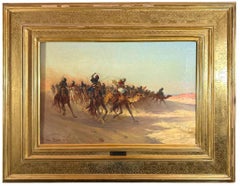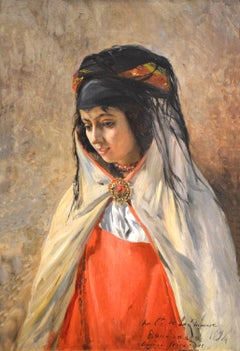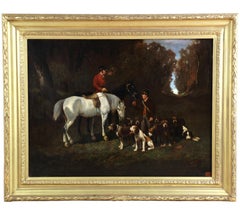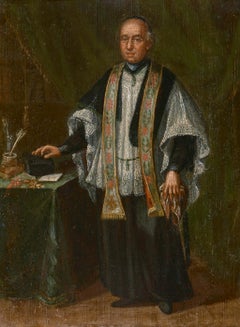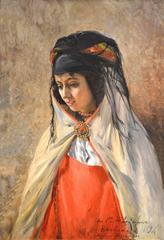Eugene Alexis Girardet Art
to
1
1
Overall Width
to
Overall Height
to
2
1
1
2
1
1
1
2
2
1
1
1
2
9,478
2,687
1,375
1,358
2
1
1
Artist: Eugene Alexis Girardet
The Charge 19th-century Realism Antique Oil Painting on Canvas, Signed
By Eugene Alexis Girardet
Located in Jacksonville, FL
The painting is signed and dated 1894
Description:
Eugene Alexis Girardet (1853-1907) was a prominent Swiss painter known for his remarkable attention to detail and his ability to capture vivid and dynamic scenes. Born in Paris, France, Girardet came from a family of artists and received early artistic training from his father, Paul Girardet, and his uncle, Jules Girardet, both respected engravers. He later studied at the prestigious École des Beaux-Arts in Paris, where he honed his skills and developed a deep appreciation for historical and orientalist subjects.
He was interred at the Père-Lachaise Cemetery. In addition to several museums in France, his works may be seen at the Dahesh Museum of Art and the National Museum of Fine Arts of Algiers, as well as at museums in Switzerland and New York City.
Girardet’s artwork often depicted historical and exotic scenes, particularly focusing on Middle Eastern and North African themes. His meticulous attention to detail and his ability to convey a sense of movement and drama made his works highly sought after. One of his most renowned paintings, “The Charge,” exemplifies his exceptional talent and his ability to create a captivating and immersive experience for viewers.
In “The Charge,” Girardet presents an army of Arab camel...
Category
19th Century Academic Eugene Alexis Girardet Art
Materials
Oil, Canvas
The Gold Brooch, Orientalist Oil Painting, Signed and dated 1894
By Eugene Alexis Girardet
Located in London, GB
Oil on panel, signed, dated and inscribed ‘Bou Saada, 1894’ lower right
Image size: 13 x 8 3/4 inches (33 x 22.25 cm)
Ornate Gilt frame
Euguene Alexis Girardet
A child prodigy, Gi...
Category
1890s Eugene Alexis Girardet Art
Materials
Oil, Panel
Related Items
Oil painting“hunting scene with dogs and horse” circle of Alfred De Dreux 19th
By Alfred de Dreux
Located in Gavere, BE
Oil painting“hunting scene with dogs and horse” attr. to Alfred De Dreux 19th
Oil on canvas, restored and cleaned in good condition.
Very nice painting for hunting scene art...
Category
1850s French School Eugene Alexis Girardet Art
Materials
Gold Leaf
$6,130
H 24.41 in W 30.32 in D 2.76 in
18th Century Venetian School Portrait of a Bishop Oil on Panel Green Brown Black
Located in Sanremo, IT
Painting oil on panel measuring 40 x 30 cm without frame and 48 x 38 with frame representing a great bishop of the Venetian school from the first half of the 18th century.
Very curi...
Category
Early 18th Century Italian School Eugene Alexis Girardet Art
Materials
Oil, Wood Panel
$1,131 Sale Price
20% Off
H 15.75 in W 11.82 in D 1.19 in
Narcissus paradigm shift Timothy Archer 21st Century Contemporary painting blue
By Timothy Archer
Located in Paris, FR
Oil paint on cvanvas
Signed lower left
Category
2010s Contemporary Eugene Alexis Girardet Art
Materials
Canvas, Oil
$6,955
H 39.38 in W 39.38 in D 1.97 in
A Fine and Charming 19th Century Oil Canvas "Children Walking the Baby Goat"
Located in LA, CA
Henry Joseph Campotosto (Belgium, 1833-1910) A Very Fine Oil on Canvas "Walking the Baby Goat", depicting two young dutch girls by the grassy shore of a river bank, one standing holding a wicker basket and a leash to a resting baby goat, the youngest sitting next to her on a pile of branches tucking her pants, a pair of ducks and ducklings swimming by the tree lined river; within a later giltwood carved frame. Signed (l/r): Campotosto Henry. Circa: Brussels, 1870.
Note: The artist is also known as Henri Campotosto
Henry or Henri Campotosto was born in Brussels in 1833. He studied in Brussels at the Royal Academy des Beaux-Arts and painted some artworks with Eugène Verboeckhoven (Belgium, 1798-1881). He received a 1st Class Medal at the Academy of Brussels and an honorable mention at the Paris Exhibition of 1860. In 1871 he moved to London with his family and remained there for life. He exhibited his work at the Royal Academy Exhibition until 1874 and at the Suffolk Street Gallery from 1878. In 1880 he took part in the Berlin Academy Exhibition. His daughter Octavia also became a painter, visited Italy, and showed her paintings at the Royal Academy from 1871 to 1874. Henri Campotosto died in London in 1910.
High Sales:
Christie's New York - Property from an American Collection, "The Bird's Nest" - Lot 247 on October 22, 2008, Sold for $37,500
Bonhams London - 19th Century European, Victorian and British Impressionist Art on 28 September 2016 - Lot 33 "Gathering flowers" Sold for £25,000 ($33,750 USD)
Museums:
The British Museum - Print of two girls and a lamb and print of two girls by a river bank
Literature
• E. Benezit Dictionnaire des Peintres, Sculpteurs, Dessinateurs, et Graveurs by Librairie Gründ - 1976 Edition - Volume 2, Page 488.
• Maurice W...
Category
19th Century Academic Eugene Alexis Girardet Art
Materials
Oil
$47,500
H 39.63 in W 31.75 in D 2.25 in
Portrait Irish Setter dog, French oil painting on panel 19th
Located in Gavere, BE
Portrait Irish Setter dog, French oil painting on panel 19th
Eugène Ferdinand PARISY was born in France in 1849 and died in 1916.
His works have been sold at public auction 68 time...
Category
1890s French School Eugene Alexis Girardet Art
Materials
Oil, Wood Panel
$4,597
H 20.48 in W 28.35 in D 1.97 in
Portrait of Elegant Child in Gilded Frame Napoleon III Era Signed
Located in Pistoia, IT
"Portrait of elegant little girl" , extraordinary oil painting on wood panel signed and dated at upper left "A. Robert 1879" for Alexandre Robert.
A Belgian painter of great talent...
Category
1870s Flemish School Eugene Alexis Girardet Art
Materials
Oil, Wood Panel
$5,658
H 26.78 in W 23.43 in
Portrait of a woman ironing
Located in BELEYMAS, FR
Paul LUNAUD
(Brantôme 1900 – 1949)
The ironer
Oil on wood
H. 80 cm; W. 64 cm
Signed and dated on the right in the center, formerly signed lower right.
1942
Provenance : Artist's stu...
Category
1940s French School Eugene Alexis Girardet Art
Materials
Oil, Wood Panel
Portrait of a young fisherman in a landscape
Located in BELEYMAS, FR
Attributed to Godfried SCHALKEN
(Made 1643 – The Hague 1706)
Young fischer
Oil on panel in one board
H. 32.5 cm; L. 25.5 cm
Around 1670/75
Related works:
- Autograph version with nu...
Category
1670s Dutch School Eugene Alexis Girardet Art
Materials
Oil, Wood Panel
Venus and Cupid
Located in BELEYMAS, FR
Hendrick Bloemaert
(Utrecht 1601/02 – Utrecht 1672)
Venus and Cupid
Oil on panel
H. 75 cm; W. 61 cm
Signed and dated 1636
Hendrick Bloemaert is a notable figure of the Golden Age of...
Category
1630s Flemish School Eugene Alexis Girardet Art
Materials
Oil, Wood Panel
Early 17th Century by Tiberio Titi Portrait of a Gentleman Oil on panel
Located in Milano, Lombardia
Tiberio Titi (Florence, Italy, 1573 – 1638)
Title: Portrait of a Gentleman
Medium: Oil on panel
Dimensions: Without frame 122 x 91 cm – with frame 162 x 133 x 10 cm
Publications: G...
Category
Early 17th Century Old Masters Eugene Alexis Girardet Art
Materials
Oil, Wood Panel
$83,845 Sale Price
20% Off
H 48.04 in W 35.83 in
Saint Ignatius of Antioch attacked by lions in the Circus and Emperor Trajan.
Located in Firenze, IT
The Martyrdom of Saint Ignatius of Antioch in the Circus during the Celebrations for Emperor Trajan - Russian School of the Mid-19th Century
Signed on the lower right. TITOV? Dated 1...
Category
Mid-19th Century Academic Eugene Alexis Girardet Art
Materials
Oil, Canvas
$2,357 Sale Price
20% Off
H 41.74 in W 28.35 in D 2.76 in
16th Century Jan van Scorel Portrait of a member of the brotherhood of Jerusalem
By Jan van Scorel
Located in Milano, Lombardia
Jan van Scorel (Schoorl, The Netherlands, 1495 – Utrecht, The Netherlands, 1562)
Title: Portrait of a member of the brotherhood of Jerusalem
Medium: Oil on panel
Dimension: without ...
Category
16th Century Old Masters Eugene Alexis Girardet Art
Materials
Oil, Wood Panel
$29,426 Sale Price
20% Off
H 24.81 in W 19.69 in
Previously Available Items
The Gold Brooch
By Eugene Alexis Girardet
Located in London, GB
Eugene Alexis Girardet
French 1853 - 1907
The Gold Brooch
Oil on panel, signed, dated and inscribed "Bou Saada, 1894" lower right
Image size: 13 x 8 ...
Category
Late 19th Century Eugene Alexis Girardet Art
Materials
Oil, Panel
Eugene Alexis Girardet art for sale on 1stDibs.
Find a wide variety of authentic Eugene Alexis Girardet art available for sale on 1stDibs. You can also browse by medium to find art by Eugene Alexis Girardet in oil paint, paint, canvas and more. Not every interior allows for large Eugene Alexis Girardet art, so small editions measuring 6 inches across are available. Customers who are interested in this artist might also find the work of Charles Zacharie Landelle, Charles Joshua Chaplin, and Emile Godchaux. Eugene Alexis Girardet art prices can differ depending upon medium, time period and other attributes. On 1stDibs, the price for these items starts at $35,161 and tops out at $95,000, while the average work can sell for $65,081.
